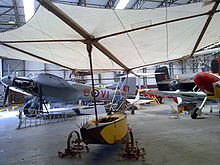George Cayley
Sir George Cayley | |
|---|---|
 George Cayley | |
| Sinh | 27 tháng 12 năm 1773 Scarborough, Yorkshire, Anh |
| Mất | 15 tháng 12 năm 1857 (83 tuổi) Brompton, Yorkshire, Anh |
| Quốc tịch | Anh |
| Nổi tiếng vì | Thiết kế tàu lượn cho con người thành công đầu tiên. Phát hiện bốn lực khí động học trọng lượng, lực nâng, lực kéo, lực đẩy và khum trên cánh bay, cơ sở cho việc thiết kế của các máy bay hiện đại |
| Sự nghiệp khoa học | |
| Ngành | Hàng không, khí động lực học, hàng không học, kỹ thuật hàng không |



Sir George Cayley, đệ lục nam tước Brompton (ngày 27 tháng 12 năm 1773 - 15 tháng 12 năm 1857) là một kỹ sư tiếng người Anh, nhà khoa học, nhà phát minh, chính trị gia người Anh. Ông mất năm mất 1857. Ông là một trong những nhân vật quan trọng nhất trong lịch sử hàng không. Nhiều người cho rằng ông là người điều tra đầu tiên thực sự của khoa học trên không và là người đầu tiên để hiểu các nguyên tắc cơ bản và các lực đẩy bay[1][2][3]. Năm 1799 ông đưa ra khái niệm của các máy bay hiện đại như là một máy bay cánh cố định với các hệ thống riêng biệt cho lực nâng, động cơ đẩy[4][5].
Tham khảo[sửa | sửa mã nguồn]
- ^ “Sir George Cayley”. Flyingmachines.org. Truy cập ngày 26 tháng 7 năm 2009.
Sir George Cayley is one of the most important people in the history of aeronautics. Many consider him the first true scientific aerial investigator and the first person to understand the underlying principles and forces of flight.
- ^ “The Pioneers: Aviation and Airmodelling”. Truy cập ngày 26 tháng 7 năm 2009.
Sir George Cayley, is sometimes called the 'Father of Aviation'. A pioneer in his field, he is credited with the first major breakthrough in heavier-than-air flight. He was the first to identify the four aerodynamic forces of flight – weight, lift, drag, and thrust – and their relationship and also the first to build a successful human carrying glider.
- ^ “U.S Centennial of Flight Commission – Sir George Cayley”. Truy cập ngày 10 tháng 9 năm 2008.
Sir George Cayley, born in 1773, is sometimes called the Father of Aviation. A pioneer in his field, Cayley literally has two great spurts of aeronautical creativity, separated by years during which he did little with the subject. He was the first to identify the four aerodynamic forces of flight – weight, lift, drag, and thrust and their relationship. He was also the first to build a successful human-carrying glider. Cayley described many of the concepts and elements of the modern aeroplane and was the first to understand and explain in engineering terms the concepts of lift and thrust.
- ^ “Aviation History”. Truy cập ngày 26 tháng 7 năm 2009.
In 1799 he set forth for the first time in history the concept of the modern aeroplane. Cayley had identified the drag vector (parallel to the flow) and the lift vector (perpendicular to the flow).
- ^ “Sir George Cayley (British Inventor and Scientist)”. Britannica. Truy cập ngày 26 tháng 7 năm 2009.
English pioneer of aerial navigation and aeronautical engineering and designer of the first successful glider to carry a human being aloft. Cayley established the modern configuration of an aeroplane as a fixed-wing flying machine with separate systems for lift, propulsion, and control as early as 1799.
